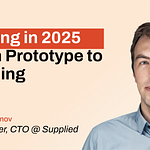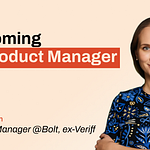Finding skilled product managers is tough—demand is higher than supply, especially in smaller markets.
To solve this, Wise started a Product Academy to train new PMs instead of spending months searching for senior ones.
In this episode, we spoke with Kristóf Litavecz, GPM at Wise, to discuss:
Why Wise built the program and its impact
The ROI of training PMs vs. hiring senior talent
5 key hiring criteria used to select PM candidates
The 700-applicant selection process and how only 6 make it
A 3-step roadmap to becoming a PM
And more
Some takeaways:
The PM talent gap is real – Wise struggled to hire senior PMs, with some roles staying open for months. Instead of competing in a limited market, they launched Product Academy to grow talent in-house.
Internal training can outperform external hiring. The academy invests in mentorship and structured learning, allowing Wise to develop six Associate PMs at a lower cost than hiring senior PMs.
The hiring funnel is highly competitive. Wise receives 700+ applications per season, narrowing them down through structured home assignments, interviews, and scorecards. Only 6 candidates make the final cut.
How Wise evaluates candidates:
Step 1: Resume screening to check for relevant experience (not fresh out of university but with 2+ years in a related role).
Step 2: Home assignment to assess structured thinking, prioritization, and problem-solving.
Step 3: Final interviews focus on 6 key criteria:
Communication skills – Can they present and defend ideas clearly?
Problem-solving ability – How do they break down complex challenges?
Data-driven thinking – Do they prioritize measuring impact?
Passion & eagerness to learn – Are they ready to handle ambiguity?
Customer focus – Do they think in terms of solving real problems?
It’s NOT an internship—it’s a full-time role. Wise pays €3,700/month before taxes to ensure associates are treated as full-fledged team members.
A proven roadmap to becoming a PM:
Step 1: Start in an operational role (CS, sales, analyst) to gain company and product context.
Step 2: Move to an execution role (project manager, sales engineer) to work on improving processes.
Step 3: Get closer to product teams and transition into a PM role—or find a Product Academy program to accelerate the shift.
Success is measured through tangible outcomes. Wise tracks the academy’s effectiveness using:
Promotion rates – How many APMs transition to full PM roles within a year?
Product impact – Are participants shipping meaningful products?
Participant satisfaction (NPS) – Do trainees feel the program sets them up for success?
Scalability – Wise refines and repeats the process for future cohorts.
Episode timestamps:
00:00 - Intro
00:58 - Why start Product Academy?
03:16 - Who can run Product Academy?
04:50 - Is it worth running Product Academy?
08:00 - Creating an appealing package. 3750 Salary.
11:30 - Do you have a scorecard to screen candidates?
14:48 - Is it an internship for University students?
18:12 - What do you expect from candidates?
18:50 - A 3-step roadmap to becoming a PM
22:03 - How did Kristof become a PM?
25:03 - An alternative way to become a PM
26:38 - AI applications
28:18 - Is program successful?
Connect with:
Kristóf Litavecz LinkedIn - https://www.linkedin.com/in/kristoflitavecz/
Nikolay Roll LinkedIn - https://www.linkedin.com/in/nikolay-roll/
Referenced:
Wise Product Academy 2024 - https://wise.jobs/job/product-academy-associate-product-manager-in-tallinn-jid-814
Enjoyed this episode? Subscribe to TPG Podcast for more insider insights on product management! 🎧













